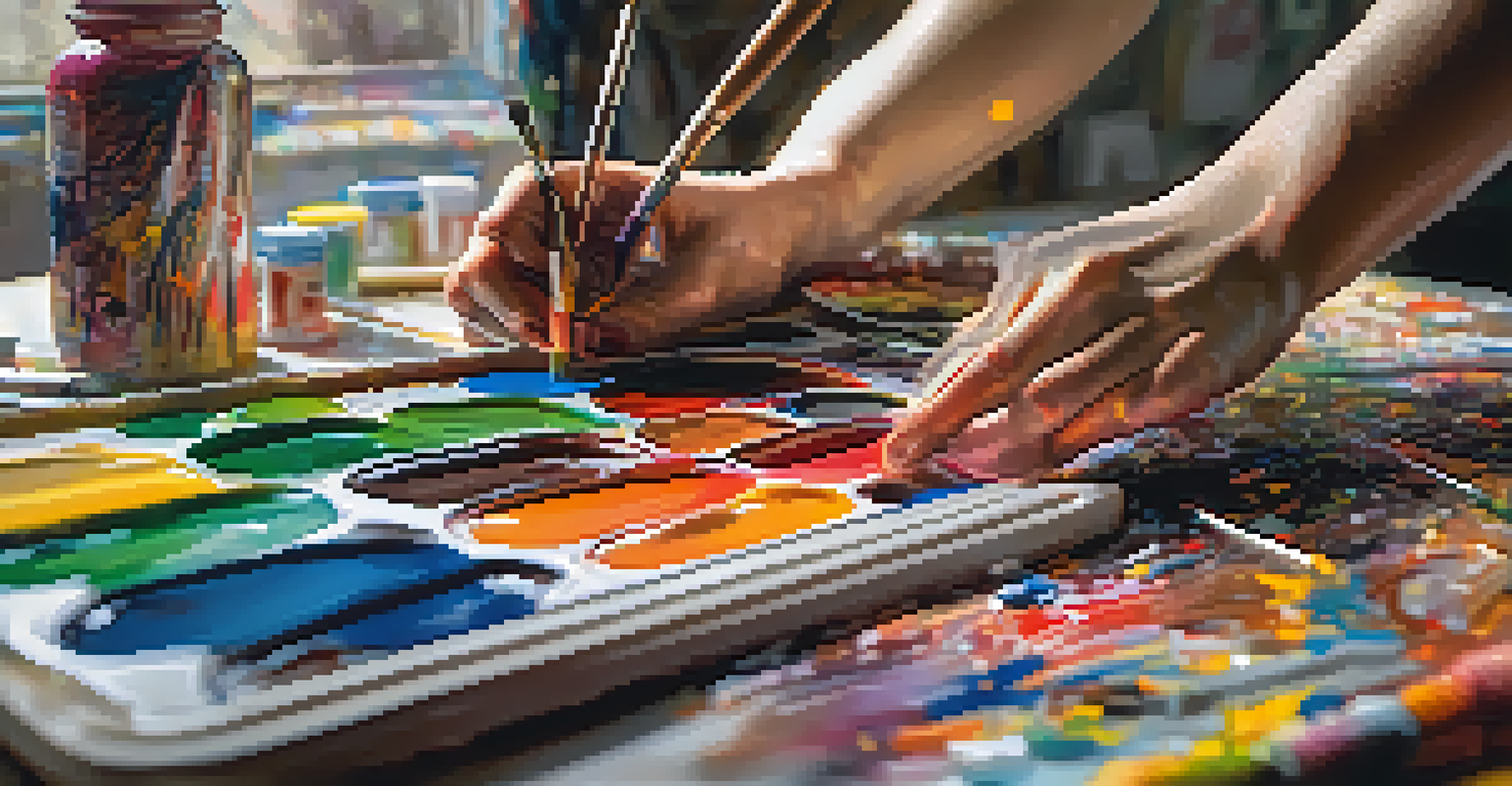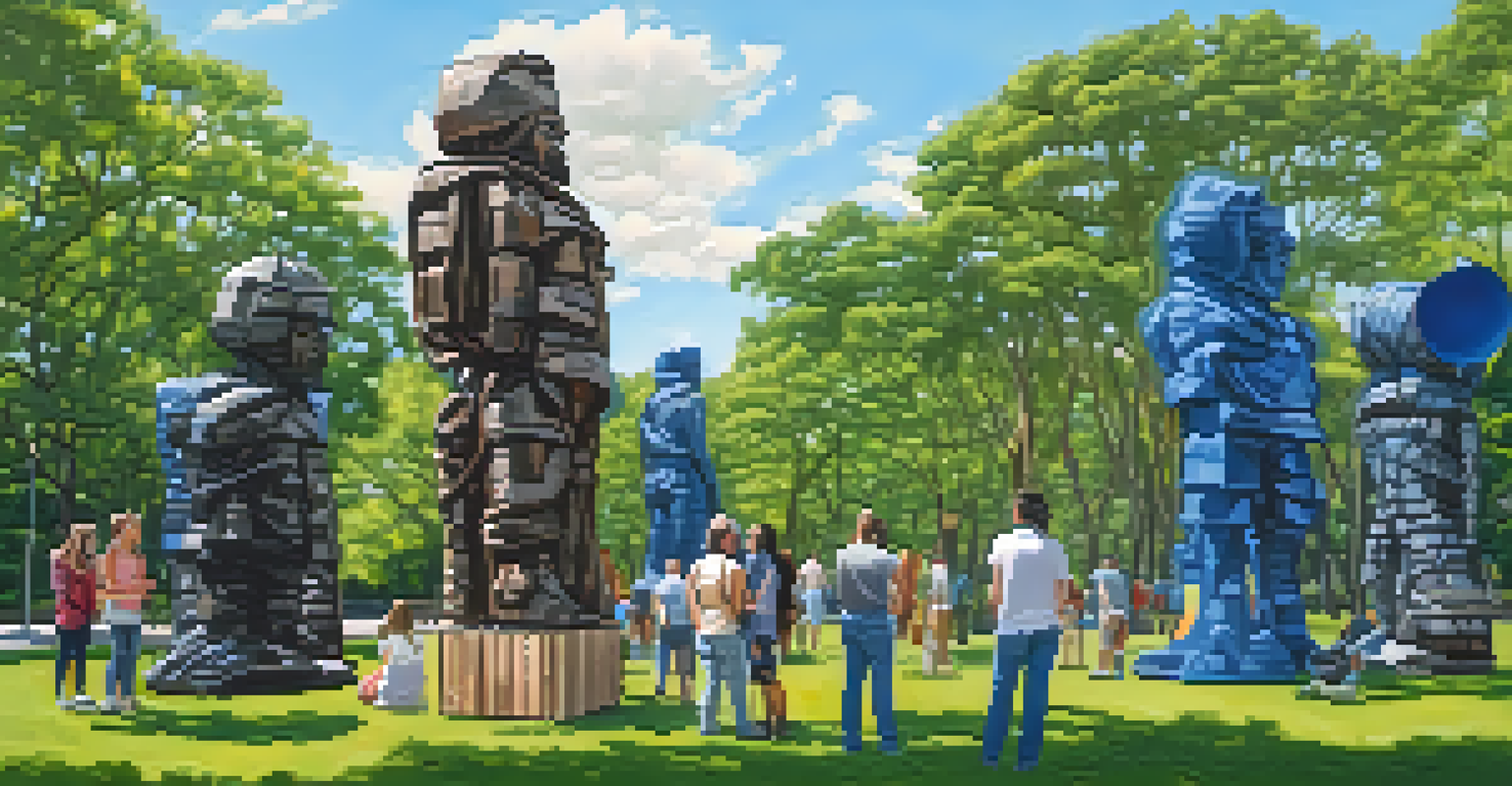Carving Identity: Artists Addressing Racial Inequality

Understanding Racial Inequality in Art
Racial inequality is a pervasive issue that affects various facets of society, including the art world. Artists often reflect their surroundings and experiences, making their work a powerful medium for addressing social issues. When racial inequality is at play, it can limit representation and influence the narratives told through art. This section explores how artists harness their creativity to shed light on these critical issues.
Art is a reflection of society, and artists have the power to change the narrative.
The art community has historically been influenced by societal norms, which often marginalize certain voices. As a response, many contemporary artists are actively challenging these narratives, using their platforms to advocate for change. For instance, artists like Kehinde Wiley and Amy Sherald have gained recognition for their portraits that not only celebrate Black identity but also confront systemic racism. Their work invites viewers to engage with the complexities of race and identity.
By addressing racial inequality, artists contribute to a broader dialogue about representation and justice. Their creations serve as both a reflection of personal experiences and a commentary on societal structures. Through various mediums like painting, sculpture, and digital art, these artists are carving out spaces for marginalized voices, ultimately enriching the art world.
The Role of Art in Social Movements
Art has long played a pivotal role in social movements, serving as a tool for activism and awareness. From protest banners to murals, artists utilize their work to amplify messages of change and justice. The recent resurgence of movements like Black Lives Matter has seen artists stepping up to create pieces that provoke thought and inspire action. This connection between art and activism highlights the transformative power of creative expression.

For example, the iconic street artist Banksy often addresses social issues through his provocative graffiti. His works challenge viewers to reconsider their perspectives on topics like inequality and injustice. Similarly, artists such as Ai Weiwei use their art as a form of protest, bringing attention to human rights violations and the plight of refugees. These examples illustrate how art can mobilize communities and spark conversations around urgent social issues.
Art as a Catalyst for Change
Artists use their creativity to challenge racial inequality and foster dialogue through their work.
In this context, art becomes more than just aesthetic; it becomes a rallying cry for change. The intersection of art and activism fosters a space where difficult conversations can occur, making it easier for audiences to engage with complex issues. By harnessing the power of creativity, artists are not only carving identities but also challenging the status quo.
Highlighting Diverse Voices in the Art World
Historically, the art world has often sidelined diverse voices, but this is changing. As awareness of racial inequality grows, there is a concerted effort to amplify underrepresented artists. Institutions, galleries, and collectors are beginning to recognize the importance of diversity in the narratives they promote. This shift not only enriches the art community but also provides a platform for artists to express their unique perspectives.
The role of the artist is to make the revolution irresistible.
Organizations like the Studio Museum in Harlem are at the forefront of celebrating Black artists and their contributions. By showcasing works that address racial and cultural identity, they provide a vital space for dialogue and understanding. Additionally, initiatives such as Art + Activism aim to connect marginalized artists with resources and audiences, ensuring their voices are heard. This creates a more inclusive art ecosystem.
The inclusion of diverse voices in art enriches the cultural landscape and fosters empathy among viewers. By engaging with a range of experiences and perspectives, audiences can gain a deeper understanding of societal issues. This not only enhances the appreciation of art but also promotes a more equitable narrative within the art world.
Personal Narratives: Artists Share Their Stories
Personal narratives can be incredibly powerful in the realm of art, especially when addressing racial inequality. Many artists draw from their own experiences to create work that resonates on a deeply personal level. By sharing their stories, they invite viewers into their worlds and encourage empathy and understanding. This connection between artist and audience makes the conversation around race more relatable.
For instance, artist Frida Kahlo's work often reflects her struggles with identity and her experiences as a woman of color. Her vivid self-portraits serve as a form of personal storytelling that continues to inspire conversations around gender and race. Similarly, contemporary artist Tatyana Fazlalizadeh uses her art to address street harassment and the intersection of race and gender, creating a platform for women of color to share their experiences.
Amplifying Diverse Voices
The art world is increasingly recognizing and promoting underrepresented artists, enriching cultural narratives.
Through personal narratives, artists are not just expressing their identities; they are also challenging viewers to confront their own biases and assumptions. This storytelling aspect of art is crucial in bridging the gap between different communities. By highlighting individual experiences, artists foster a collective understanding of racial inequality and inspire change.
Collaborative Art Projects for Change
Collaboration among artists can amplify the impact of their work, especially when addressing social issues like racial inequality. Collaborative art projects often bring together diverse voices, creating a tapestry of perspectives that can resonate with a wider audience. These projects can take many forms, from community murals to large-scale installations. The collective effort not only strengthens the message but also fosters a sense of unity in the fight for equality.
For example, the 'Say Their Names' project honors victims of police violence through art, inviting artists from various backgrounds to contribute their voices. This collaborative approach not only memorializes those lost but also raises awareness about systemic racism. Additionally, initiatives like 'The Black Joy Project' celebrate Black culture and identity through the collaborative efforts of artists, fostering a positive dialogue around race.
Such collaborative projects highlight the importance of community in addressing racial inequality. By working together, artists can create more impactful messages that resonate with audiences on multiple levels. These initiatives serve as a reminder that art can be a powerful tool for collective healing and social change.
The Impact of Digital Art on Racial Dialogue
The digital age has transformed how art is created and consumed, opening new avenues for discussing racial inequality. Social media platforms allow artists to share their work with a global audience, making it easier to spread messages of awareness and change. Digital art can take many forms, from graphic design to video installations, providing artists with versatile tools to express their thoughts on race and identity.
For instance, artists like Shantell Martin use digital platforms to create interactive art that engages viewers in real-time. By inviting participation, Martin's work fosters dialogue and encourages audiences to reflect on their own experiences with race. Additionally, memes and digital illustrations have become powerful tools for raising awareness about social issues, reaching audiences who may not engage with traditional forms of art.
Digital Art Sparks Racial Dialogue
The digital age enables artists to reach global audiences, facilitating conversations about race and identity.
The impact of digital art extends beyond mere visibility; it creates a space for dialogue and connection. By utilizing the internet, artists can reach diverse audiences and spark conversations about racial inequality. This democratization of art allows for broader representation and can lead to meaningful change in societal perceptions of race.
Art's Role in Shaping Future Conversations on Race
As the art world evolves, its role in shaping conversations around race and identity becomes increasingly important. Artists are not just creators; they are also cultural commentators who reflect and influence societal attitudes. The themes they explore can pave the way for future discussions about racial inequality, encouraging audiences to think critically about these issues. This ongoing dialogue is essential for fostering a more inclusive society.
For example, the resurgence of art addressing the Black Lives Matter movement has sparked a renewed interest in discussions about systemic racism. Artists are using their platforms to challenge viewers to confront their biases and engage in difficult conversations. Through exhibitions, public art, and online campaigns, they are shaping the narrative around race and identity.

Looking ahead, it is crucial for the art community to continue prioritizing diverse voices and perspectives. By doing so, they can create a richer cultural landscape that reflects the complexities of society. Ultimately, art has the potential to be a transformative force, driving conversations that lead to greater understanding and change.